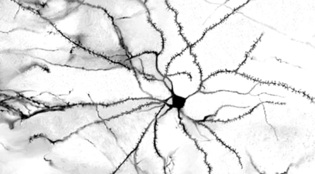 loading
loading
The chemical secrets of memory Grazyna Gorny, provided by Terry RobinsonThis image of a neuron from the brain of a rat shows the dendrites branching from the central cell body and, growing on the dendrites, multiple tiny spines. Dendritic spines, specialized structures that receive signals from other neurons, are crucial in encoding information—including the processes of forming and keeping memories. View full imageHow are memories made and kept? The process is mostly uncharted territory. "The human brain contains 100 million neurons, but not all of them are involved in encoding any one memory," says Sheena Josselyn, a neuroscientist at the University of Toronto. "Each memory is encoded by a different network of individual cells. So the next important areas to look at will be: which cells? How do these cells communicate with their neighbors, and how is this network hooked up?" Some of the basics are clear. To store information, the brain forms networks of nerve cells, joined by the flow of signals through synapses. New experiences may change the strength or weakness of the synapses, eliminate them entirely, or build new ones. This changing flow of signals changes the shape and chemistry of the networks, and therefore the information they store. In this process, the synapses are central. Signals pass through a synapse from the axon of one cell to the dendrite of another. The receiving end of most synapses is a structure called a dendritic spine—a tiny filament that grows on the dendrite like a thorn on a blackberry stem. But unlike thorns, the spines change shape, grow larger or smaller, and disappear or multiply. Very broadly speaking, the hypothesis goes like this: more spines mean more memories; larger spines mean more-durable memories. And so dendritic spines are now a central focus of brain research. Biologists have been chipping away at the mysteries of their formation, literally molecule by molecule, identifying essential chemicals and their functions. An enzyme called MAP kinase activates the mechanism that makes proteins for building new spines. CREB and MKK1 together regulate spine shape, so that spines are smaller when there are many and larger when there are few. MMP-9 drives the enlargement of spines. And the list goes on. So many chemicals play essential parts that scientists speak of these cellular processes as "cascades" of molecules. Frick doesn't usually work at the molecular level. But one of the studies she published in 2008 was a breakthrough involving a type of MAP kinase. Other scientists had shown that the molecule—known as ERK, for extracellular signal-regulated kinase—is crucial to consolidating memories. Among other things, it initiates the formation of proteins that reshape spines for long-term memory. Frick wondered if estrogen might play some role in activating ERK. To test the theory, she and the students in her lab first did chemical analyses showing that female mice injected with estrogen experience a surge in ERK activation in the hippocampus. Then they tested for long-term memories. They gave one group of mice estrogen injections, and another group estrogen plus a drug known to block ERK's activation in the hippocampus. The first group of mice performed well at remembering toys they had seen two days earlier. The second group—the one that received the ERK inhibitor—did not. This result shows that estrogen's power to enhance memory depends on whether or not it is able to activate ERK. The study is the first to link estrogen to one of the chemical processes that create memories: as Duke University's Williams puts it, Frick has "been able to pinpoint a specific pathway in the brain." Identifying such pathways is the first step in finding ways to target them that can improve memory with minimal side effects, says Bruce McEwen of Rockefeller. Ordinarily, estrogen acts on many different tissues in the body—breast and uterine tissue, among others. The real question is, says McEwen, "Could you develop an estrogen-like compound that would do all the good things and none of the bad things? That's the holy grail for this line of research." A precisely targeted drug, Williams adds, might benefit men as well as women. Such a drug may, of course, be decades away, if it ever materializes at all. Frick sees the ERK study as "just the beginning of the story." She's planning to redo the study in middle-aged mice, to better simulate the critical period of life when estrogen supplements may have the most pronounced effects on memory. More broadly, she hopes to assemble, over time, a detailed road map of how estrogen acts on the brain: "There are probably heaps of molecules that play a role in how estrogen affects memory, so we're going to continue to look at other aspects of cell signaling. What genes is estrogen changing? What are the important proteins that neurons are using under estrogen's influence?" The research is key to unraveling the supremely mysterious mechanism the brain uses to make memories. And one day, it may lead to that powerful memory aid. Says Frick, "The women I talk to tell me, 'Work faster—we need this!'"
The comment period has expired.
|
|